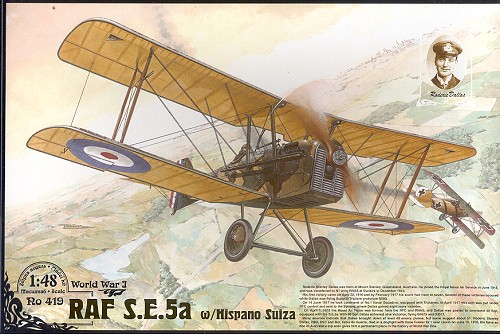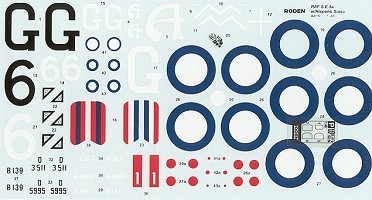
| KIT: | Roden 1/48 SE.5a (Hispano Suiza) |
| KIT #: | 419 |
| PRICE: | $19.98 (17.96 at Squadron) |
| DECALS: | Six options |
| REVIEWER: | Scott Van Aken |
| NOTES: |

| HISTORY |
Thanks to www.rodenplant.com for the historical background.
| THE KIT |
 By
now most of us have realized that Roden is here to stay. They have found a
place in the modeling community and a method of producing and choosing
subjects that have not only enthusiast interest, but a lot of staying
power. This latest SE.5a kit is a great example of that. When Roden designs
a kit, they generally do but a single set of sprues. Then they either
include the bits for all variants in the box or (as they did in the past)
provide those additional parts needed to a base set of sprues.
By
now most of us have realized that Roden is here to stay. They have found a
place in the modeling community and a method of producing and choosing
subjects that have not only enthusiast interest, but a lot of staying
power. This latest SE.5a kit is a great example of that. When Roden designs
a kit, they generally do but a single set of sprues. Then they either
include the bits for all variants in the box or (as they did in the past)
provide those additional parts needed to a base set of sprues.
With the SE.5 series, they've chosen to put everything on two sprues. This means a plethora of options and some parts that are not used. The molding on these parts is as good as you'll find almost anywhere. The fabric representations are especially good as they look as prototypical as any I've ever seen. No 'hills and valleys', but nice, taught fabric on these. The parts themselves are well detailed and relatively free from flash, major sink areas and embarrassing ejector pin marks. I did find a tiny bit of flash on a prop or two and there are a couple of sink areas found on the lower front fuselage, but by and large, it is a pretty clean mold. A small acetate sheet with four different windscreen shapes is included
You'll find three different cockpit sections, four different props, two different engine covers, two different radiators, as well as optional bits such as a head rest and bombs. Many of these bits are completely dependent on which aircraft is being modeled as WWI aircraft were not as uniformly produced as one would find nowadays. A dozen different makers of a design would often find differences in details and even in engines used.
 This is all detailed in the
instructions. They are very well done with clear construction sequences
that differentiate between the optional bits when time comes to attach
them. The instructions also provide color references in Humbrol and generic
names. A well-drawn rigging diagram is provided, a necessary addition as
the SE.5a had quite a bit of it. Markings are provided for six aircraft,
five of them in Matte WWI Green over linen. These planes are from 56 Sq
(two options), 143 Sq, 60 Sq, and 111 Sq. These planes have geometric
patterns on the rear fuselage and the 143 Sq had night insignia. The real
interesting camo (as was seen on the Sopwith Salamander) is the 40 Sq
option. This is a disruptive scheme of Matte Light Earth and Matte
Chocolate over the standard Green shade. The decal sheet is large and very
well printed. Judging from the sheet I used with the 1/32 Dr.I, this sheet
should work just great, but the white may be a bit transparent so some
backing is suggested for the disruptive camo scheme.
This is all detailed in the
instructions. They are very well done with clear construction sequences
that differentiate between the optional bits when time comes to attach
them. The instructions also provide color references in Humbrol and generic
names. A well-drawn rigging diagram is provided, a necessary addition as
the SE.5a had quite a bit of it. Markings are provided for six aircraft,
five of them in Matte WWI Green over linen. These planes are from 56 Sq
(two options), 143 Sq, 60 Sq, and 111 Sq. These planes have geometric
patterns on the rear fuselage and the 143 Sq had night insignia. The real
interesting camo (as was seen on the Sopwith Salamander) is the 40 Sq
option. This is a disruptive scheme of Matte Light Earth and Matte
Chocolate over the standard Green shade. The decal sheet is large and very
well printed. Judging from the sheet I used with the 1/32 Dr.I, this sheet
should work just great, but the white may be a bit transparent so some
backing is suggested for the disruptive camo scheme.
| CONCLUSIONS |
This is another really fine Roden WWI kit. Roden is fast becoming a major player in the production of WWI models for the enthusiast. One can only hope that not only will this continue, but that we'll be seeing some of these enlarged to 1/32 scale.
July 2005
If you would like your product reviewed fairly and fairly quickly by a site that has around 300,000 visitors a month, please contact me or see other details in the Note to Contributors.